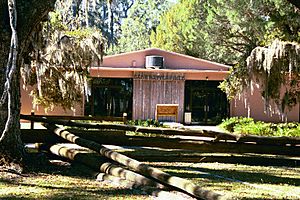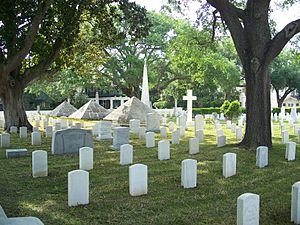Dade battle facts for kids
Quick facts for kids Dade battle |
|||||||
|---|---|---|---|---|---|---|---|
| Part of Second Seminole War | |||||||
 Dade Battlefield |
|||||||
|
|||||||
| Belligerents | |||||||
| Seminole | |||||||
| Commanders and leaders | |||||||
| Micanopy Thlocklo Tustenuggee |
|||||||
| Strength | |||||||
| 180 | 110 | ||||||
| Casualties and losses | |||||||
| 3 killed 5 wounded |
108 killed 1 wounded |
||||||
The Dade battle was a major military defeat for the United States Army in 1835. It is sometimes called the Dade massacre. This event happened during the Second Seminole War. The U.S. government wanted to make the Seminole people leave their homes in Florida. They planned to move them to a new area called Indian Territory, which is now part of Oklahoma.
In this battle, 110 U.S. soldiers, led by Major Francis L. Dade, were marching through Florida. They were suddenly attacked by about 180 Seminole warriors. Almost all the U.S. soldiers died. Only three survived the ambush, and one of them passed away the next day from his injuries. The Second Seminole War continued until 1842. After that, most Seminoles were forced to move from Florida.
What Happened at the Dade Battle?
On December 23, 1835, Major Francis L. Dade and his 110 soldiers left Fort Brooke (which is now Tampa). They were heading north on a military road. Their mission was to bring supplies and more soldiers to Fort King (now Ocala).
The Seminole people in Florida were very angry. The U.S. Army was trying to force them to move far away from their lands. Major Dade knew his soldiers might be attacked. He thought an attack would happen when they crossed rivers or went through thick forests. After passing these areas, he felt safer. He even called back his scouts to help his group move faster.
The area they were in had pine trees and palmetto plants. These plants were not tall enough to hide someone standing up. But they were perfect for warriors to hide by crouching or lying down. The Seminoles had waited to attack because they were hoping Osceola would join them. However, Osceola was busy elsewhere. So, they decided to attack without him.
Seminole scouts secretly watched the U.S. troops. They wore sky-blue uniforms. The scouts sent messages back to their chiefs about the soldiers' movements. The troops marched for five quiet days. Then, on December 28, they were just south of today's city of Bushnell. They were walking through a high area with oaks, pines, cabbage palms, and saw palmetto.
Suddenly, a shot was fired. Many reports say that Major Dade and half his men were killed right away. The Seminoles had about 180 warriors waiting. They had the advantage of the land and surprise. Major Dade, who was riding a horse, was killed by the very first shot. This shot was fired by Chief Micanopy, which was the signal for the attack to begin.
After Major Dade died, Captain George W. Gardiner took command. Many soldiers, who were marching in two lines, were quickly killed. Only a few managed to get their flintlock muskets out from under their heavy winter coats.
An Eyewitness Account
A Seminole leader named Halpatter Tustenuggee, also known as Alligator, later described the battle. He said they had been planning this attack for over a year. They moved into the pine forest at dawn. He counted 180 warriors. Each warrior chose a hiding spot.
Alligator said that around nine in the morning, the soldiers came close. When all the soldiers were in position, a signal was given. Chief Micanopy fired the first rifle shot. Then, every Indian stood up and fired. This killed more than half of the white soldiers right away. The soldiers fired their cannon several times. But the men loading it were shot down as soon as the smoke cleared.
Alligator and his warriors thought everyone was dead and started to leave. But then an Indian said the white men were building a small fort out of logs. Alligator and another leader, Jumper, went back with ten warriors. They saw six men hiding behind two logs. The cannon was a short distance away. The warriors got close, and the soldiers' bullets flew over them. The soldiers had guns but no powder. The fighting stopped around noon. Alligator said they left many people looking at the dead soldiers. He also reported that three Seminole warriors were killed and five were wounded.
The battle started around 8 or 10 in the morning and ended around 4 in the afternoon. The Seminoles left around sunset. They took food, some clothes, and ammunition. They did not scalp or loot other items.
What Happened After the Battle?
Only three U.S. soldiers survived the attack. Private Edward Decourcey was covered by dead bodies. Private Ransom Clark was stripped of his clothes and left for dead. The Seminoles were focused on getting guns, ammunition, and supplies. The next day, a Seminole warrior pursued Decourcey and Clark. Decourcey was killed. Clark managed to make it back to Fort Brooke. He collapsed near the fort and was helped the rest of the way by a friendly Native American woman. Clark's story was the only detailed account from the Army's side.
A third soldier, Private Joseph Sprague, also survived. He was wounded in the arm. He reached Fort Brooke on New Year's Day 1836. He continued to serve in the army for many years.
In 1837, Louis Pacheco, a slave who guided and interpreted for Major Dade's group, gave another account of the battle. He said he was ahead of the column and was captured by the Seminoles. Some people thought he might have helped the Seminoles. He was later sent west with some Seminole people.
After the battle, many large farms were burned. Settlers were killed. By the end of 1836, almost every house in what is now Miami-Dade County and Broward County had been destroyed by the Seminoles. The Seminoles felt stronger after their victory against Dade's command. They also had success in other battles.
News of the Dade battle spread quickly. It was a major topic in national news. President Andrew Jackson asked for volunteers from Florida, Georgia, and South Carolina to fight. General Winfield Scott was sent to Florida to lead all U.S. forces.
Two months later, on February 20, 1836, General Edmund P. Gaines and 1100 men reached the Dade battlefield. They were the first U.S. soldiers to return to the site. They buried the dead soldiers there. Later, after the war ended in 1842, the soldiers' remains were moved. They were reburied in St. Augustine National Cemetery. Their remains rest under three stone pyramids. These pyramids also hold the remains of over 1,300 other U.S. soldiers who died in the Second Seminole War.
The Dade Monument (West Point), built in 1845, also honors the battle. Today, people hold yearly reenactments of the battle at the Dade Battlefield State Historic Site.


